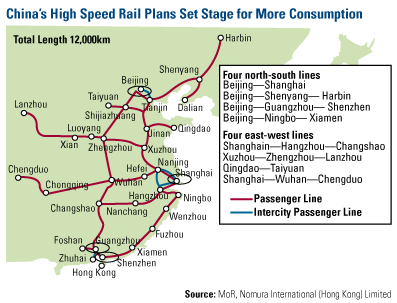This week’s Emerging Markets Diary highlighted the growth of high-speed rails in China, with its recent launch of the line between Shanghai and Hangzhou. The Shanghai-Hangzhou line now lets passengers shrink their travel time to only 45 minutes for a distance of about 126 miles.
This chart from Nomura International illustrates part of China’s current five-year plan to expand its network of high speed rails. China already has the longest high speed rail system in the world with just under 2,200 miles of track but Beijing has plans to extend its high speed rail lines to a total of 8,078 miles by 2012. By 2020, some analysts expect the distance of high speed rail lines to stretch 12,427 miles.
 Most surprising about this is the speed in which China has been able to lay the tracks. China’s first high speed line between Beijing and Tianjin just opened in 2008 and has already carried 40 million passengers, roughly 125,000 a day.
Most surprising about this is the speed in which China has been able to lay the tracks. China’s first high speed line between Beijing and Tianjin just opened in 2008 and has already carried 40 million passengers, roughly 125,000 a day.
Traveling at 180 miles per hour, high-speed rails have cut the travel time between Shanghai and Beijing from 14 hours to 5 hours. These trains are also equipped with Wi-Fi and other amenities so businesspeople can continue to work while they travel.
Another large project underway is a rail line to the province of Xinjiang, in far western China. This 1,103 miles high speed rail line is important because it frees up the existing rail line for freight traffic. Xinjang’s 2.9 trillion tons of coal reserves make it one of the richest deposits in China and connecting these reserves with power hungry cities along China’s coast is essential to making sure the lights stay on.
Recently, Beijing has ramped up efforts to develop China’s western regions. The Chinese government has been encouraging urbanization into the country’s interior regions by offering incentives such as tax free zones and building out the region’s infrastructure. Tourism into western provinces has also seen a bump, and retail development for luxury goods such as Hermes, Cartier and others has begun popping up across the western landscape.
This chart first appeared in this week’s edition of the Emerging Markets Diary.












